If you need to bug out or pack light, then you’ll want to embrace any gear that can serve multiple uses.
We all know that ponchos are great for rain gear.
But did you know they can also act as a shelter or tent?
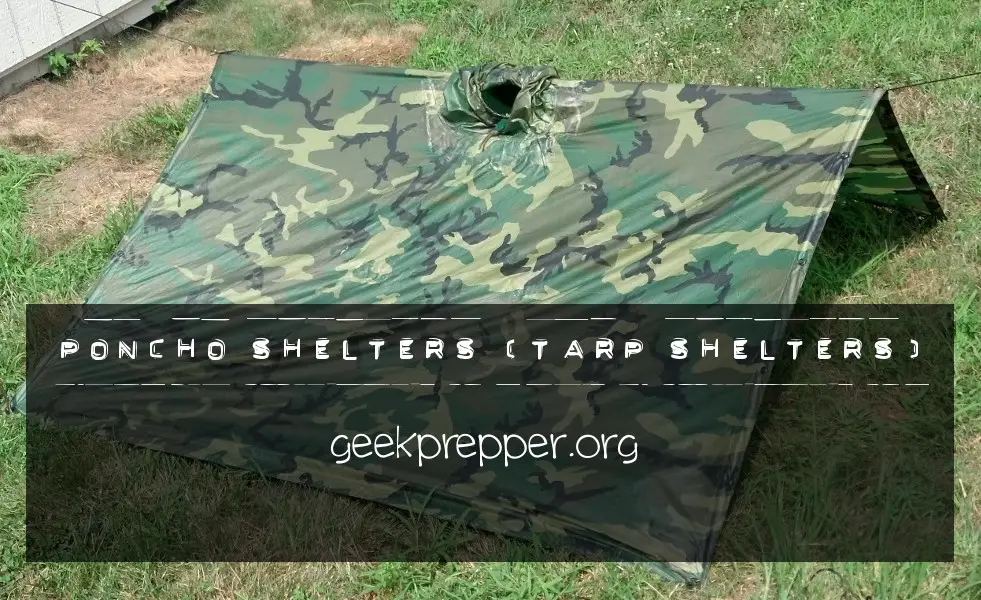
Poncho Shelters (Tarp Shelters)
I am a big fan of multi-purpose gear.
That’s why I have a Military Poncho in my Get Home Bag (GHB) and have one in each of my vehicles. If I’m somewhere and it starts raining, I whip out the Poncho and, BAM, there’s my raincoat. If things go really bad, and I’m walking home, the poncho can act as a shelter or tent.
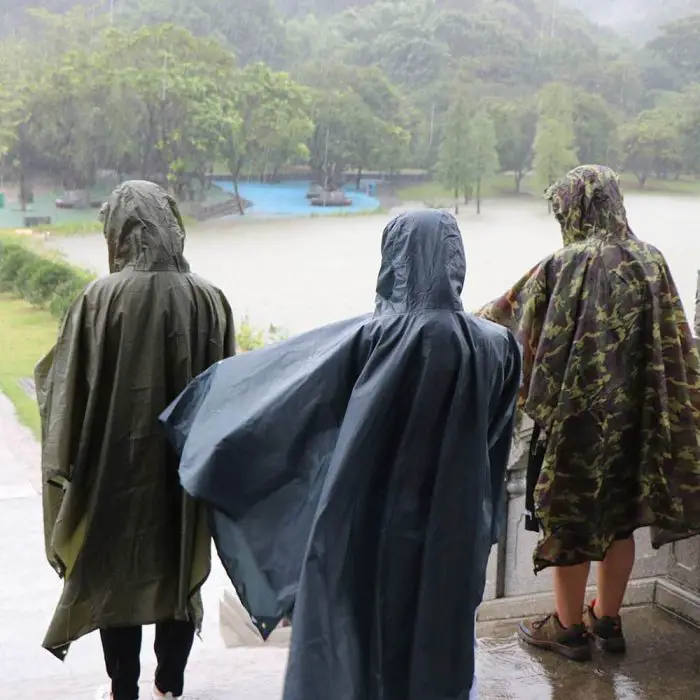
Before we get too far into this post, I should mention that you don’t have to use a Military Poncho, a decent tarp can act as a tent, but keep in mind, that a tarp might look really strange for every day rain gear.
“But, John, we already have a tent….”
I know, I know. All you readers, that have a family, are thinking that you may not need a Military Poncho or a camouflage tarp because you already have a tent. I disagree. If you are bugging out, or are on the run with your family in tow, chances are you have a tent.
I don’t know what’s happened in the tent industry, but every tent I see these days is a bright orange or yellow color. You might want to use a sizable camouflage tarp to cover that brightly colored tent.
I’d also point out that someone has to stay awake on guard duty, while your family is fast asleep.
If it’s raining you may want to wrap up in your poncho or tarp to stay dry or to erect a shelter, where you have a view of the approach to your campsite.
Poncho Shelter 1: Pup Tent Style
Yes, I did use my children’s jungle gym, since we have no mature trees in our back yard. This does prove that you can practice your outdoor skills without leaving your yard!
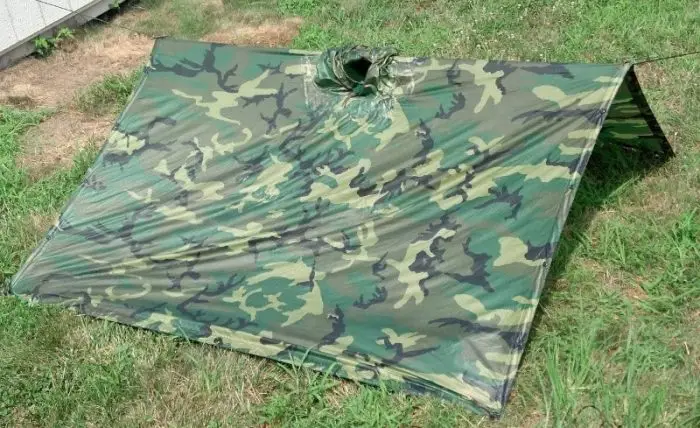
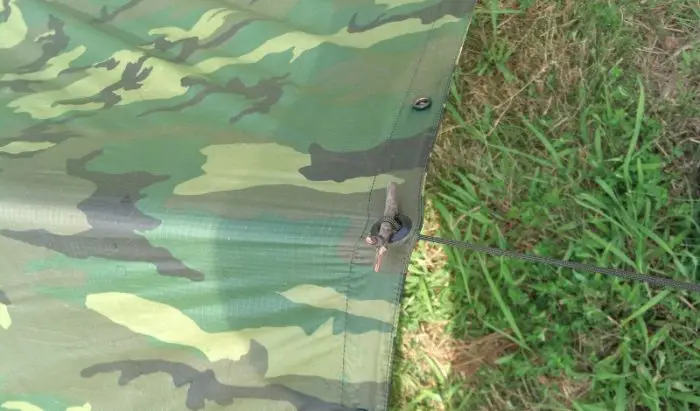
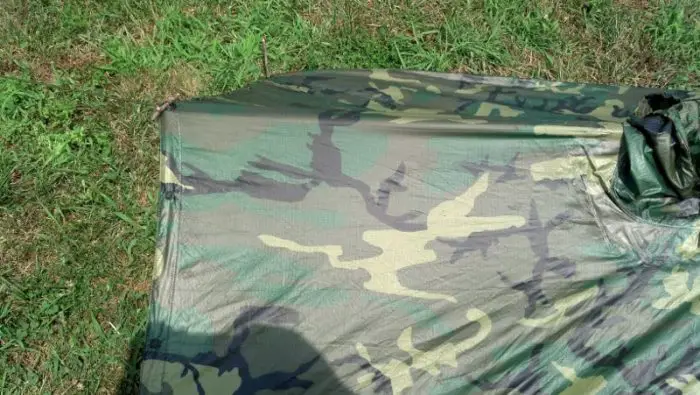


I typically like to tie my paracord to an anchor point like a tree (ok ok..or a jungle gym), then push a loop of cord through one of the grommets and insert a twig into the loop, then repeat on the other side of the poncho.
This way I don’t have to cut my paracord or tie fancy knots to the grommets. I can also adjust the tension or tightness of the poncho. Check out the pictures for more info.
Normally I would tie the hood area shut to prevent precipitation entering my cozy shelter, but it was really hot, so in that case, I leave it open to vent heat, like a gable vent.
Poncho Shelter 2 : Pup Tent Style 2
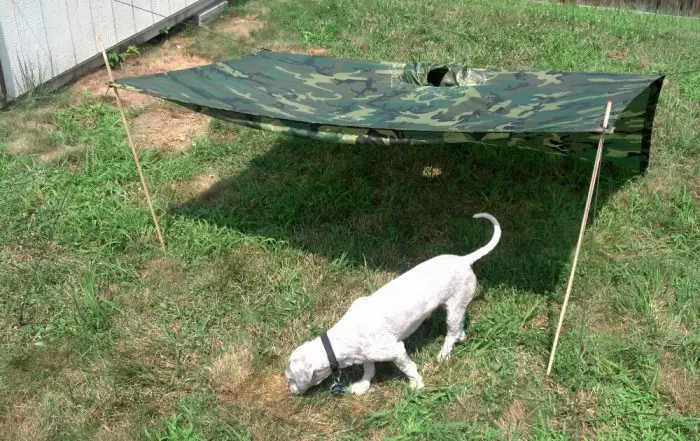
This is a variation of the pup tent style of Poncho Shelter 1.
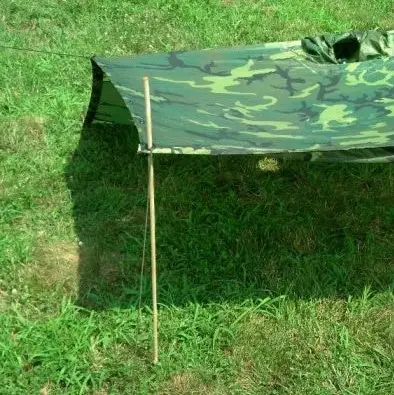
I use sticks (I had dowel rods handy today, that’s not typical in the forest) to hold up the front of the shelter for visibility and airflow or to keep an eye on a campfire. This would also allow heat from a campfire to heat the inside area.
I know these shelters aren’t pretty, but I was only using twigs and a Swiss Army Knife to build it.
Imagine how great this shelter would have been if I had tent stakes and a mallet (or shovel) to drive those stakes into the ground. I’ll be showing some other Military Poncho shelter variations in upcoming posts.
| Poncho Shelters* | Tarp Shelters |
*Poncho Shelters from a US military manual
Poncho Shelter 3: Lean-To
The next poncho shelter is what is referred to as the lean-to.

I find this poncho shelter configuration best during low wind conditions. You can also use a blanket for this in a pinch, as mentioned a tarp or a poncho is preferred for all the reasons mentioned above (waterproof, durable, and camouflage).
Look for ponchos with built-in grommets. This makes the easier to build and preventing it from getting torn by the wind.
If your poncho comes with snap closures then attaching them will be easy, allowing you to create a bigger shelter. Tie the poncho to a stake, which you can make from readily available materials – among which are fallen tree branches.
Choose Y-shape branches as much as possible as they make better stakes for your poncho shelter.
Poncho Shelter 4: A-Frame Shelter
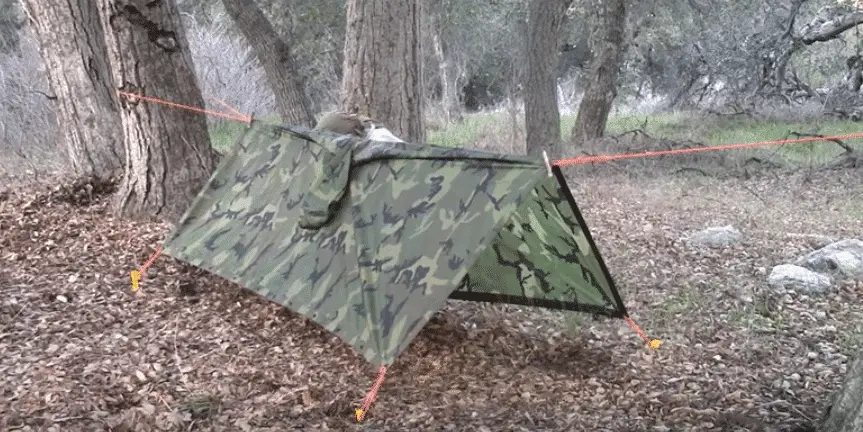
You may also want to try out a poncho A-frame shelter made of leaves and branches.
A poncho equipped with snaps would be ideal with the A-fame for attaching more than one poncho together. Sometimes creating an A-frame shelter requires attaching a couple of ponchos.
However, if you have a bigger poncho, then you can build this shelter simply by splitting the poncho down the middle after tying the cordage between two trees (or whatever works (posts, shrubs, etc). Grommets are handy for this build as well, since it allows for holes to weave the cordage, creating a secure “spine” for the A-frame.
Poncho Shelter 5: The Hooch
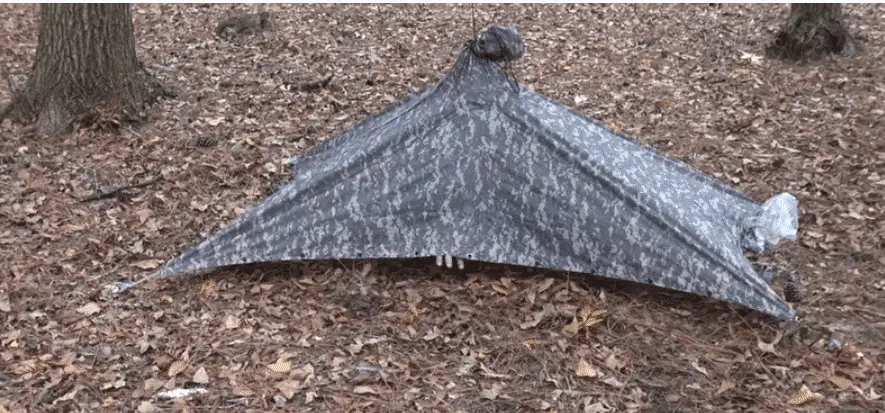
This configuration is what we call as the Hooch Shelter.
To build, look for a strong tree branch. The hood area of your poncho should then be tied to cordage from the branch. You can then secure the final shelter build by securing all corners using tent stakes or branches.
This shelter is ideal with more concealment is needed from all angles looking at the tent from the outside, since most of the tarp will cover the occupants and contents.
Poncho Shelter 6: The Cauldron
The next poncho shelter configuration I would like to recommend is the cauldron.
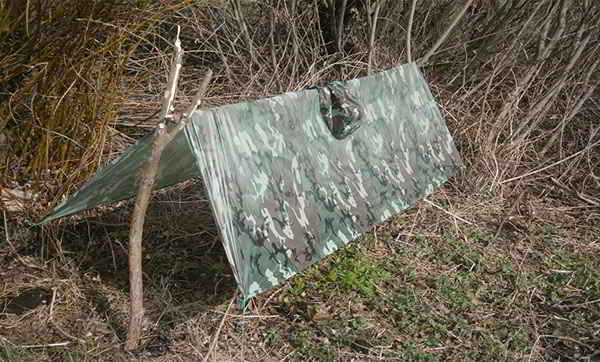
For this, three branches may be needed – the two should be Y-shaped and the other one should be a clean, straight branch, (free of off-shooting branches and twigs)
Push the first two Y shaped branches into the ground. Put the straight and clean branch on top, across the Y branches.
What you should be after is a structure that is somewhat the same as a cauldron holder. Once done, you can drape your poncho across the top horizontal branch. Secure this shelter by tying off all four corners to to the ground through the grommets
Poncho Shelter 7: The Ghost Man
Another easy to build shelter is “The Ghost Man”. Building this poncho shelter requires a few simple steps. Find two trees or posts to tie off to. Then find a clean and smooth branch to position through the top of the hood to the ground.
Make sure the stick is not too long or short, so to stretch the shelter just enough to make the structure tight, but not so much that it will risk tearing the hood. I would also advise to round the end of the branch that is stretching the top of the hood, also to help avoid tares.
This configuration serves a couple of purposes – such as a sun-shed, rain-shed, and hunting blind. It is the perfect poncho shelter you can make in environments with no to moderate rain and wind.
Top 5 Military Ponchos that can Be Turned into a Shelter
The following military ponchos are tough and versatile enough that you will be able to use them as poncho shelters if the situation calls for it.

1) Foxelli Hooded Rain Poncho
This poncho from Foxelli is durable and sturdy enough that it will provide protection from heavy winds and rain.
It is top-notch quality and it is tear-resistant. The superior durability of this item also makes it suitable for use as a shelter. It also serves other uses, such as acting as a sleeping bag cover, camping blanket, or tent cover.
You may also put it over a sunshade to make it even more protective.
2) Anyoo Waterproof Rain Poncho
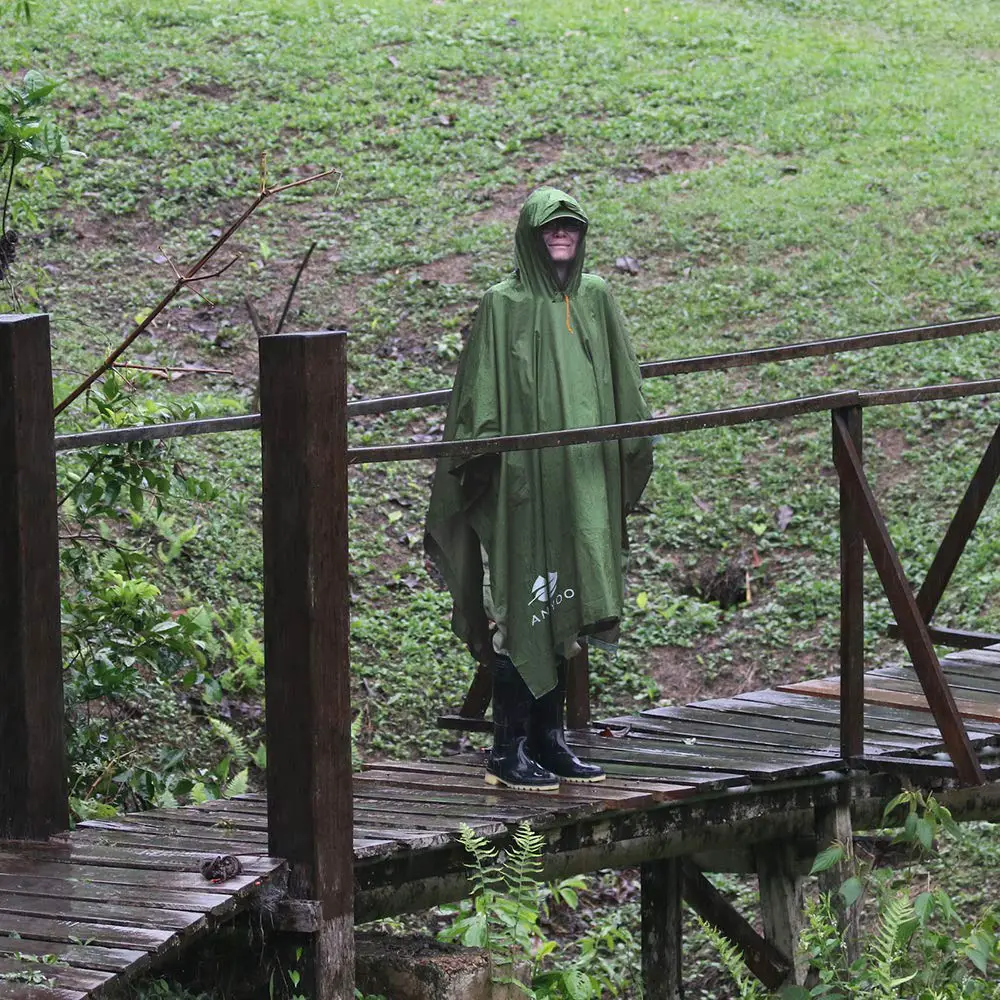
This is another poncho designed to ensure that you stay dry in whatever situation you are in.
It comes with a hood that can protect your face. It also features hook-and-loop fasteners that do not only guarantee a comfortable and secure fit but also promote ease of attachment in case you plan to use the poncho for your shelter. You can also find eyelets at the poncho’s hem, which you can use in turning it into a shelter or a groundsheet.
3) Arcturus Rain Poncho
This multifunctional rain poncho from Arcturus offers several advantages and serves several purposes for both backpackers and survivalists.
Aside from acting as a poncho, you can use it as an emergency shelter, groundsheet, or tarp.
It is waterproof and sturdy, so you do not have to worry about it ripping or tearing. Furthermore, it is compact and lightweight so bringing it on your camping trips will be less hassle.
4) Fire Force 8740 Nylon Poncho
You will also love the Fire Force 8740 Nylon Poncho because of its proven durability and simple construction. Constructed from nylon rip-stop fabric, you can have confidence in this poncho’s strength. It even has a water-repellent urethane coating.
Furthermore, it is equipped with a total of six eyelets or grommets to aid in building a poncho shelter.
5) M-Tac Rip-stop Waterproof Poncho
Another multifunctional poncho you should consider investing in is this one offered by M-Tac.
Aside from working efficiently as a rain poncho, it also works as a sleeping bag, blanket, tarp, and shelter tent. It is large enough and has metal grommets equipped with a cord, promoting ease of use when building a shelter..

Other Uses of a Poncho
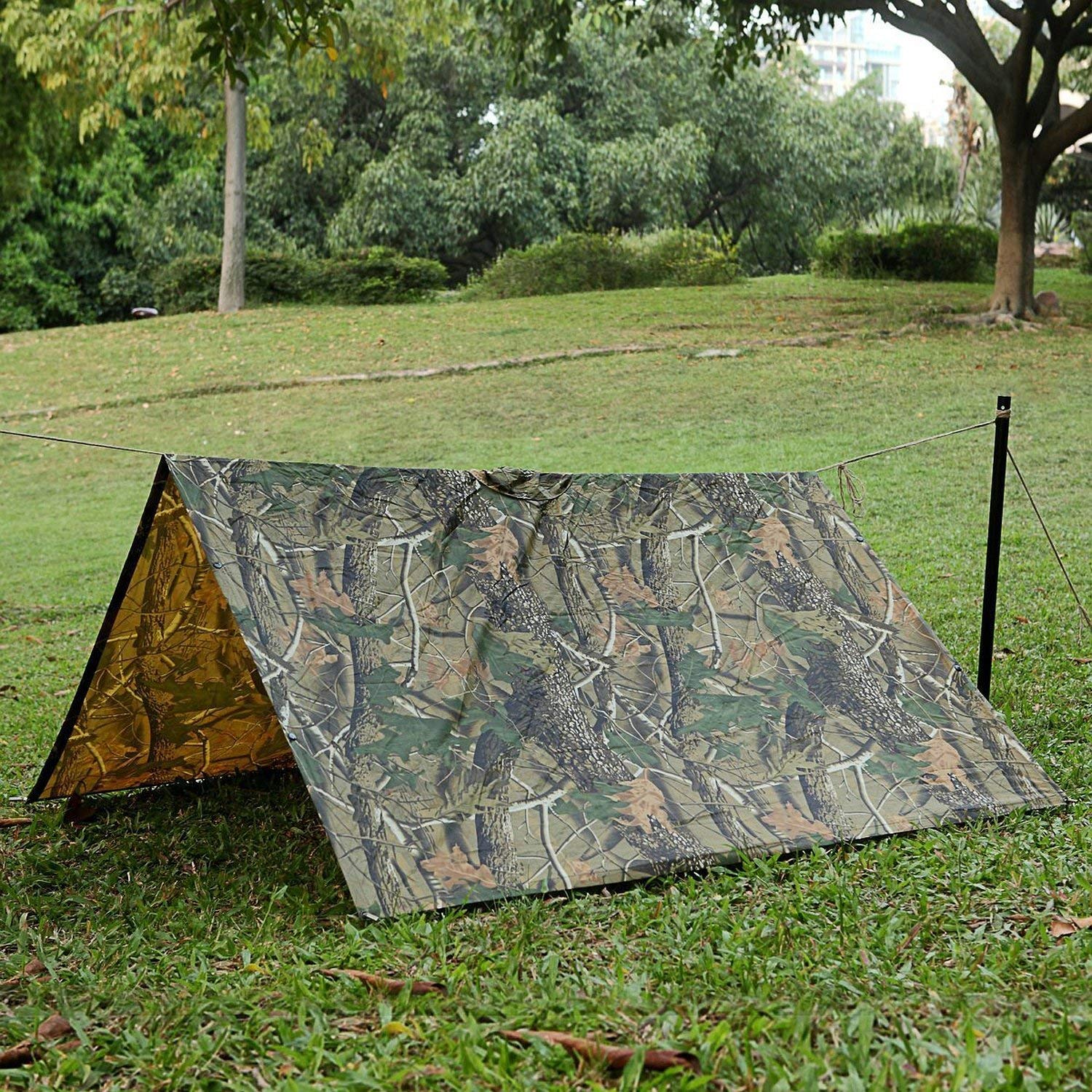
Aside from working efficiently as a shelter, a military poncho can also serve other purposes during survival situations, making it a truly sound investment. Here are just a few additional functions that every prepper and survivalist will love:
- Used to conceal your gear and yourself – You can use it to hide your caches and keep them protected from the harsh weather.
- Curtain or door – If you are making a shelter in the wilderness then you can also use the poncho as its curtain or door.The reinforced grommets integrated into it come in handy for this, too. Using it as a curtain or door can prevent bugs from coming inside your shelter, promote better retention of heat, and offers more shade.
- Rainwater collector – If you don’t have a source of water close to you and you suddenly run out then your poncho can serve as your lifesaver as it can help collect water from rain. The best way to do this is to dig a hole in the ground. Put the poncho there. Expect this to be filled up with water after a rain. Or, you can use the poncho to capture and divert rain into a container that is ready for storage and/or drinking.
A military poncho is a versatile item that you can incorporate into your survival gear. Make it a part of your survival kit and you will surely have something to use for a wide range of purposes.
I wanted to show you how Ponchos (or tarps) and a bit of paracord can make very decent Poncho Shelters. Using multi-purpose gear can save important space in your pack, that you can use for other essentials! Also, see our Tent Survival and Shelter Mastery post with buyers guide.
If you liked this post, come like us on Facebook (Geek Prepper), or subscribe to our newsletter, to see our new posts.


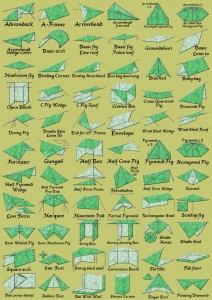
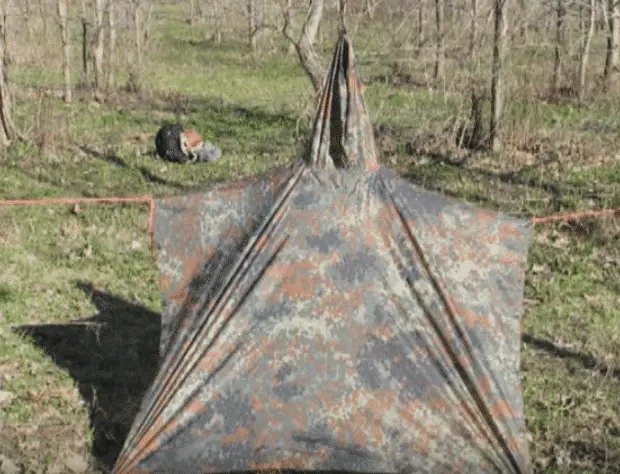
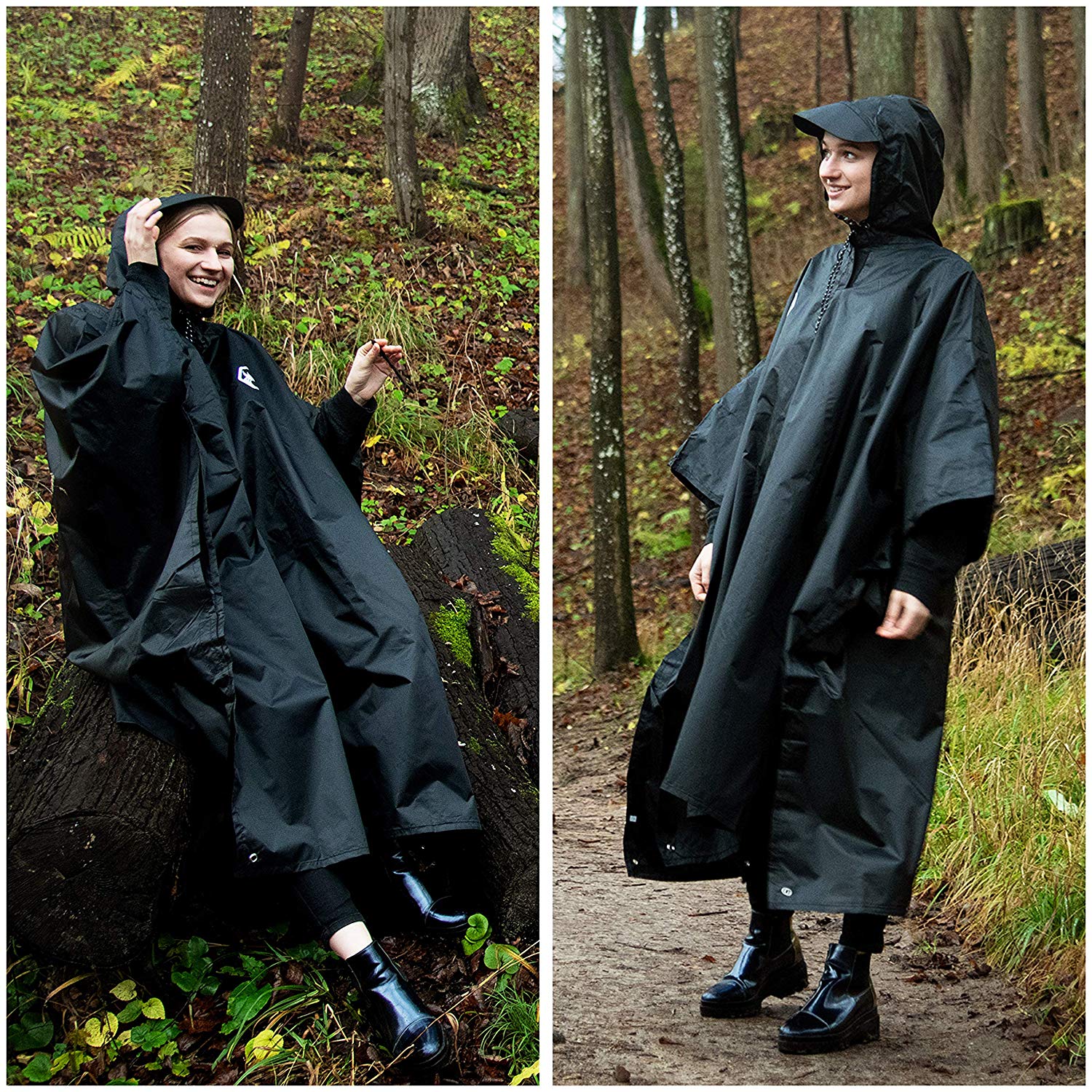


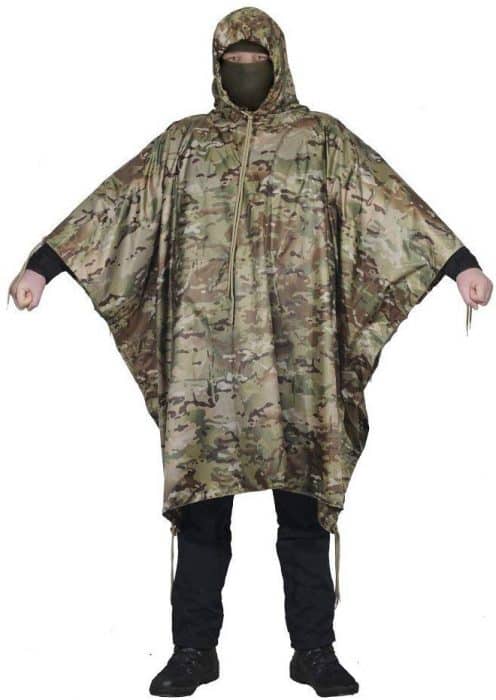
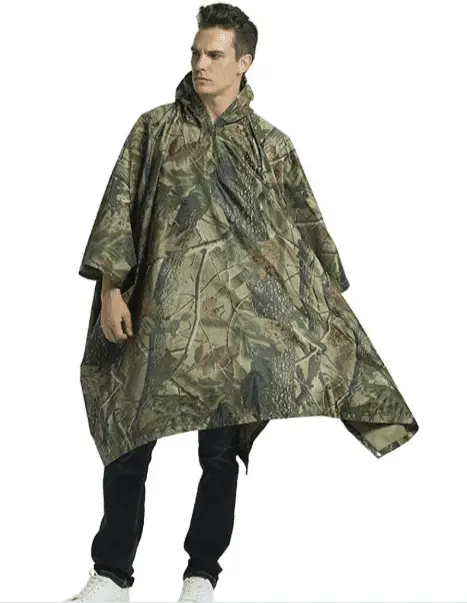
Only a few of these are practical, the rest are a waste of time. In a SHTF situation you do not have time to waste setting up fancy shelters until you get to your BO site. Then you want something a little more permanent than a tarp shelter.
Es muy buena idea, adenas muy util tambien puede constrir una hamaca con el poncho.
One of the best uses for tarps that we use is to cover the fire pit area. Once you have the area figured out where your gong to build your fire, stretch the tarp between 4 trees as high as you can reach over the area. Angle the trap slightly down hill away from the fire so that any unexpected rain flows away from your fire. This will keep you and your fire dry if a rain storm should pop up, this also gives you a dry place to store fire wood in a rain storm.
The wind break idea comes in very handy during winter camping as well!
When i went though outward bound I solo with a kitchen tarp in the winter and 2 1/2 feet of snow I set it up similar to a bakers tent and kept a small fire under it for cooking and warmth when they came to check on me I was laying on top of my bag in my long johns When I was in the service I camped out in a tarp often in the summer in the winter I used a hex tent but I kept my tarp handy in case I got stuck some where
Really shows the flexibility of a tarp, if you use your noodle.